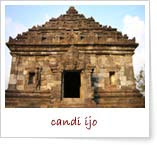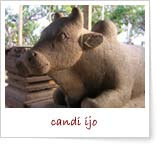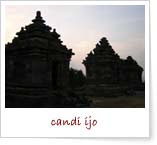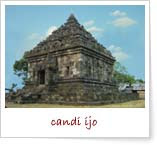
Ijo
Temple was built in around the ninth century on a hill named the Green
Hill of which height is 410 meters above the sea level. Because of this
height, we can enjoy not only the temple but also natural view below
such as terraces of agriculture land with its steep slope. Even though
this is not a fertile area, natural view around the temple is so
beautiful to enjoy.
The complex of the temple consists of 17
building structures that are divided into 11 terraces. The first
terrace functioning as the yard leading to the entrance is a terrace
with staircase stretching from west to east. The building on the
eleventh terrace is in the form of encircling wall, eight pole phallus,
four buildings namely the main temple, and three ancillary temples. The
placement of the building on each terrace is based on the level of its
being sacral. The building on the highest terrace is the most sacral.

Variants
of painting are found since the entrance of this Hindu temple. Right on
the entrance gate, there is a motif of double head giant and some of
its attributes. Such motif and attributes found in Buddhist temples
show that such temples are acculturation forms of Hindu and Buddha
cultures. Some temples having such giant motif are Ngawen, Plaosan and
Sari.
There is also a statue describing flying woman and man
directing to certain side. Such description can have some meanings;
first, as spells to expel evil spirit and second as symbol of unity
between god Siva and goddess Umi. The unity is meant as the onset of
universe creation. Different from the statues in Prambanan Temple,
natural style of the statues in Ijo Temple do not lead to eroticism.

Approaching
the ancillary temples on the eleventh terrace, there is a pit possible
used to burn sacrifice. Right on the upper part of the pit back wall
there are ventilations in the forms of trapezium and triangle. The pit
reflects the Hindu community that adores Brahma, the god of fire. The
three ancillary temples show community adoration to the three Hindu
gods, namely Brahma, Siva, and Vishnu.
Some of the works that keep
mystery are two inscriptions located in the temple building on the
ninth terrace. One of the inscriptions is coded by letter F with the
writing Guywan or Bluyutan meaning place for meditation. Another
inscription is made of stone as high as 14 cm and as thick as 9 cm
containing magic spells that are predicted to be curses. The magic
spells were written 16 times and parts of them read "Om Sarwwawinasa,
Sarwwawinasa." The two inscriptions may relate closely to certain
occurrences in Java by that time. What were the occurrences? They are
not revealed yet up to now.

Visiting
this temple, you will find beautiful scenery that other temples do not
have. Looking down westwards, you will see airplane taking off and
landing at Adisutjipto International Airport. You see this scenery
because the Seribu Mountains where Ijo Temple is located is the border
of the east part of the airport. It is because of the presence of this
temple that Adisutjipto Airport cannot be lengthened eastwards.
Each
detail of the temple presents meaningful thing and invites the visitors
to make a reflection so that the journey will not just be fun time.
Great paintings without the name of the creators show life philosophy
of the past Javanese community that emphasized more on moral message
presented by the works rather than the creators or the greatness of
their works.





